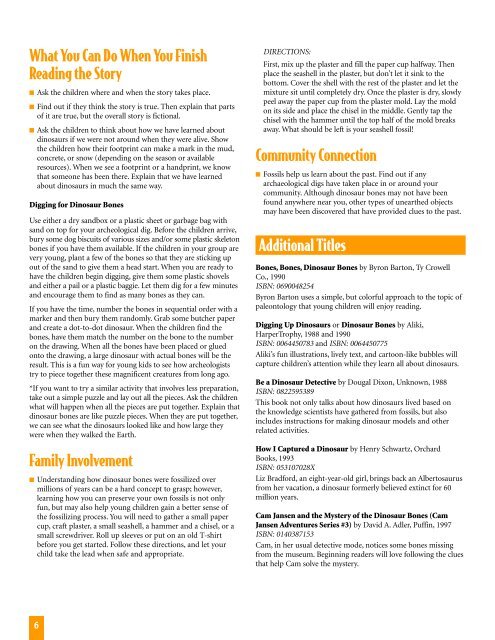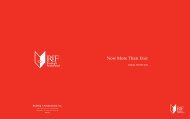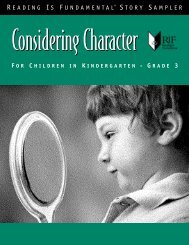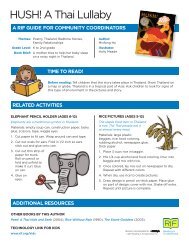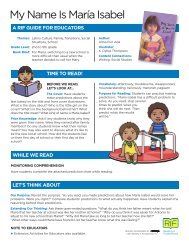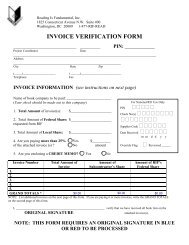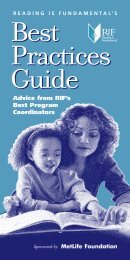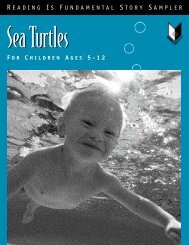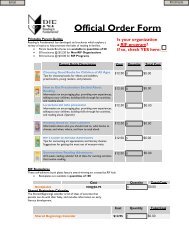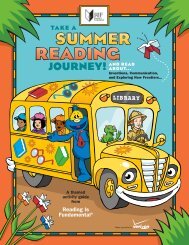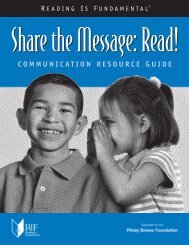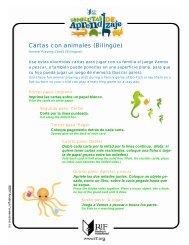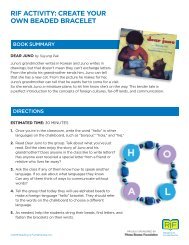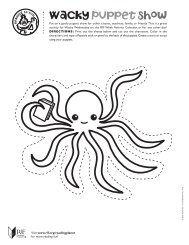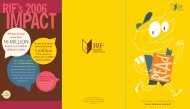Dinosaurs Story Sampler - Reading Is Fundamental
Dinosaurs Story Sampler - Reading Is Fundamental
Dinosaurs Story Sampler - Reading Is Fundamental
You also want an ePaper? Increase the reach of your titles
YUMPU automatically turns print PDFs into web optimized ePapers that Google loves.
What You Can Do When You Finish<br />
<strong>Reading</strong> the <strong>Story</strong><br />
■ Ask the children where and when the story takes place.<br />
■ Find out if they think the story is true. Then explain that parts<br />
of it are true, but the overall story is fictional.<br />
■ Ask the children to think about how we have learned about<br />
dinosaurs if we were not around when they were alive. Show<br />
the children how their footprint can make a mark in the mud,<br />
concrete, or snow (depending on the season or available<br />
resources). When we see a footprint or a handprint, we know<br />
that someone has been there. Explain that we have learned<br />
about dinosaurs in much the same way.<br />
Digging for Dinosaur Bones<br />
Use either a dry sandbox or a plastic sheet or garbage bag with<br />
sand on top for your archeological dig. Before the children arrive,<br />
bury some dog biscuits of various sizes and/or some plastic skeleton<br />
bones if you have them available. If the children in your group are<br />
very young, plant a few of the bones so that they are sticking up<br />
out of the sand to give them a head start. When you are ready to<br />
have the children begin digging, give them some plastic shovels<br />
and either a pail or a plastic baggie. Let them dig for a few minutes<br />
and encourage them to find as many bones as they can.<br />
If you have the time, number the bones in sequential order with a<br />
marker and then bury them randomly. Grab some butcher paper<br />
and create a dot-to-dot dinosaur. When the children find the<br />
bones, have them match the number on the bone to the number<br />
on the drawing. When all the bones have been placed or glued<br />
onto the drawing, a large dinosaur with actual bones will be the<br />
result. This is a fun way for young kids to see how archeologists<br />
try to piece together these magnificent creatures from long ago.<br />
*If you want to try a similar activity that involves less preparation,<br />
take out a simple puzzle and lay out all the pieces. Ask the children<br />
what will happen when all the pieces are put together. Explain that<br />
dinosaur bones are like puzzle pieces. When they are put together,<br />
we can see what the dinosaurs looked like and how large they<br />
were when they walked the Earth.<br />
Family Involvement<br />
■ Understanding how dinosaur bones were fossilized over<br />
millions of years can be a hard concept to grasp; however,<br />
learning how you can preserve your own fossils is not only<br />
fun, but may also help young children gain a better sense of<br />
the fossilizing process. You will need to gather a small paper<br />
cup, craft plaster, a small seashell, a hammer and a chisel, or a<br />
small screwdriver. Roll up sleeves or put on an old T-shirt<br />
before you get started. Follow these directions, and let your<br />
child take the lead when safe and appropriate.<br />
6<br />
DIRECTIONS:<br />
First, mix up the plaster and fill the paper cup halfway. Then<br />
place the seashell in the plaster, but don’t let it sink to the<br />
bottom. Cover the shell with the rest of the plaster and let the<br />
mixture sit until completely dry. Once the plaster is dry, slowly<br />
peel away the paper cup from the plaster mold. Lay the mold<br />
on its side and place the chisel in the middle. Gently tap the<br />
chisel with the hammer until the top half of the mold breaks<br />
away.What should be left is your seashell fossil!<br />
Community Connection<br />
■ Fossils help us learn about the past. Find out if any<br />
archaeological digs have taken place in or around your<br />
community. Although dinosaur bones may not have been<br />
found anywhere near you, other types of unearthed objects<br />
may have been discovered that have provided clues to the past.<br />
Additional Titles<br />
Bones, Bones, Dinosaur Bones by Byron Barton, Ty Crowell<br />
Co., 1990<br />
ISBN: 0690048254<br />
Byron Barton uses a simple, but colorful approach to the topic of<br />
paleontology that young children will enjoy reading.<br />
Digging Up <strong>Dinosaurs</strong> or Dinosaur Bones by Aliki,<br />
HarperTrophy, 1988 and 1990<br />
ISBN: 0064450783 and ISBN: 0064450775<br />
Aliki’s fun illustrations, lively text, and cartoon-like bubbles will<br />
capture children’s attention while they learn all about dinosaurs.<br />
Be a Dinosaur Detective by Dougal Dixon, Unknown, 1988<br />
ISBN: 0822595389<br />
This book not only talks about how dinosaurs lived based on<br />
the knowledge scientists have gathered from fossils, but also<br />
includes instructions for making dinosaur models and other<br />
related activities.<br />
How I Captured a Dinosaur by Henry Schwartz, Orchard<br />
Books, 1993<br />
ISBN: 053107028X<br />
Liz Bradford, an eight-year-old girl, brings back an Albertosaurus<br />
from her vacation, a dinosaur formerly believed extinct for 60<br />
million years.<br />
Cam Jansen and the Mystery of the Dinosaur Bones (Cam<br />
Jansen Adventures Series #3) by David A. Adler, Puffin, 1997<br />
ISBN: 0140387153<br />
Cam, in her usual detective mode, notices some bones missing<br />
from the museum. Beginning readers will love following the clues<br />
that help Cam solve the mystery.


